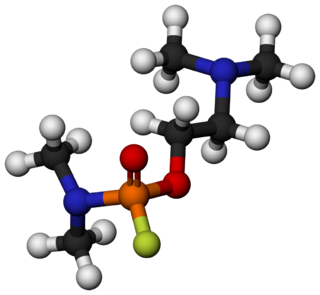Pseudoalteromonas is a genus of marine bacteria. In 1995, Gauthier et al proposed Pseudoalteromonas as a new genus to be split from Alteromonas. The Pseudoalteromonas species that were described before 1995 were originally part of the genus Alteromonas, and were reassigned to Pseudoalteromonas based on their rRNA-DNA analysis.
The Alteromonadaceae are a family of Pseudomonadota. They are now one of several families in the order Alteromonadales, including Alteromonas and its closest relatives. Species of this family are mostly rod-like shaped and motile by using one polar flagellum.

GV is an organophosphate nerve agent. GV is a part of a new series of nerve agents with properties similar to both the "G-series" and "V-series". It is a potent acetylcholinesterase inhibitor with properties similar to other nerve agents, being a highly poisonous vapour. Treatment for poisoning with GV involves drugs such as atropine, benactyzine, obidoxime, and HI-6.
Alteromonas is a genus of Pseudomonadota found in sea water, either in the open ocean or in the coast. It is Gram-negative. Its cells are curved rods with a single polar flagellum.

Petalura litorea, commonly known as the coastal petaltail, is an endangered Australian species of dragonfly from the family Petaluridae.

Vaucheria litorea is a species of yellow-green algae (Xanthophyceae). It grows in a filamentous fashion. V. litorea is a common intertidal species of coastal brackish waters and salt marshes of the Northern Atlantic, along the coasts of Europe, North America and New Zealand. It is also found in the Eastern Pacific coasts of Washington state. It is found to be able to tolerate a large range of salinities, making it euryhaline.
Pseudoalteromonas aurantia is an antibacterial-producing marine bacterium commonly found in Mediterranean waters. In 1979, Gauthier and Breittmayer first named it Alteromonas aurantia to include it in the genus Alteromonas that was described seven years earlier, in 1972 by Baumann et al. In 1995, Gauthier et al renamed Alteromonas aurantia to Pseudoalteromonas aurantia to include it in their proposed new genus, Pseudoalteromonas, which they recommended splitting from Alteromonas.
Pseudoalteromonas citrea is a yellow-pigmented marine bacterium that is antibiotic-producing and was isolated from Mediterranean waters off Nice. Originally named Alteromonas citrea, nearly two decades later it was reclassified as part of the Genus Pseudoalteromonas.
Pseudoalteromonas espejiana is a marine bacterium.
Pseudoalteromonas luteoviolacea is a marine bacterium which was isolated from seawater near Nice.
Pseudoalteromonas rubra is a marine bacterium.
Pseudoalteromonas undina is a marine bacterium isolated from seawater off the coast of Northern California. It was originally classified as Alteromonas undina but was reclassified in 1995 to the genus Pseudoalteromonas.
Alteromonas addita is a marine bacterium.
Alteromonas hispanica is a marine bacterium.
Alteromonas genovensis is a marine bacterium.
Alteromonas macleodii is a species of widespread marine bacterium found in surface waters across temperate and tropical regions. First discovered in a survey of aerobic bacteria in 1972, A. macleodii has since been placed within the phylum Pseudomonadota and is recognised as a prominent component of surface waters between 0 and 50 metres. Alteromonas macleodii has a single circular DNA chromosome of 4.6 million base pairs. Variable regions in the genome of A. macleodii confer functional diversity to closely related strains and facilitate different lifestyles and strategies. Certain A. macleodii strains are currently being explored for their industrial uses, including in cosmetics, bioethanol production and rare earth mining.
Alteromonas marina is a marine bacterium.
Alteromonas simiduii is a marine bacterium.
Alteromonas stellipolaris is a marine bacterium.
Alteromonas tagae is a marine bacterium.


